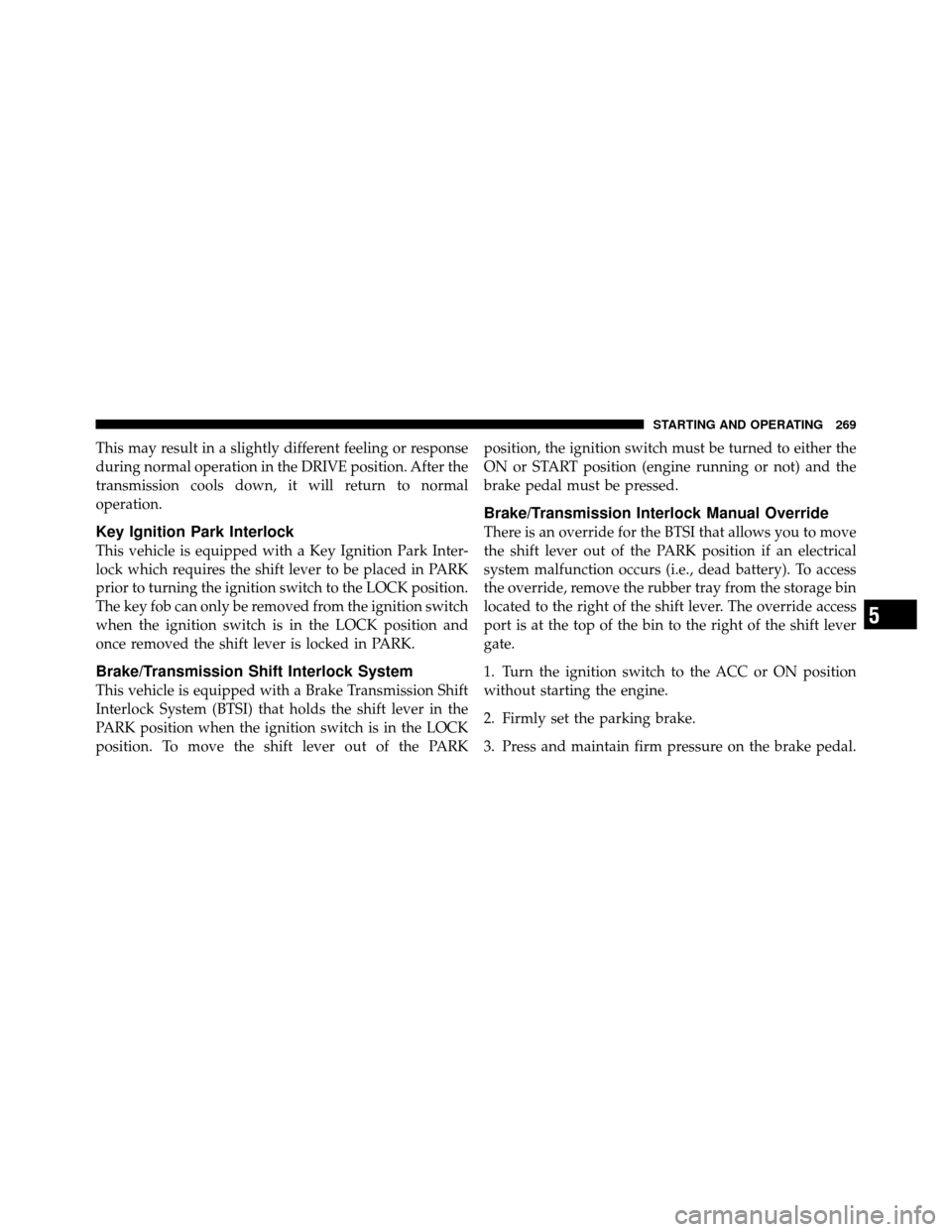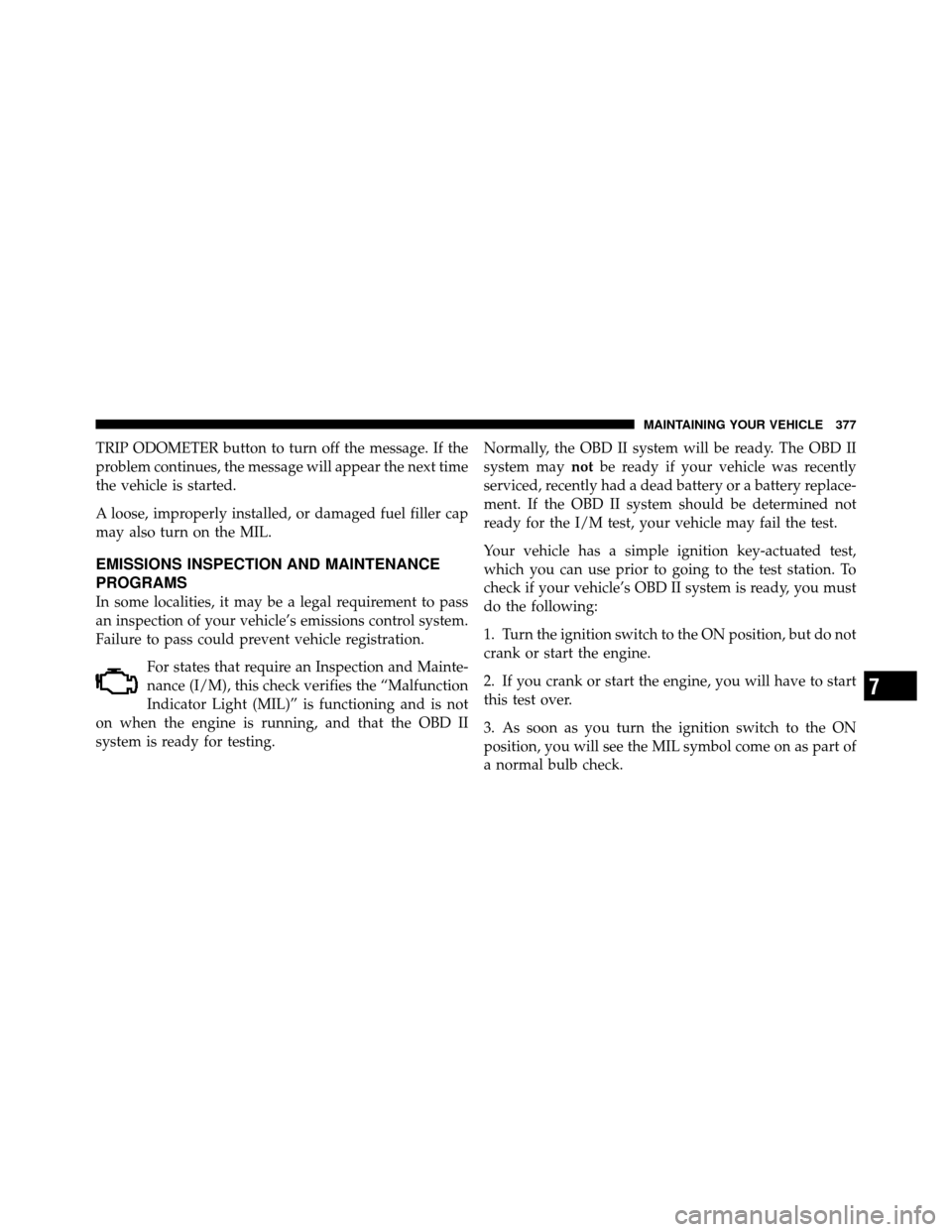Page 270 of 484

This may result in a slightly different feeling or response
during normal operation in the DRIVE position. After the
transmission cools down, it will return to normal
operation.
Key Ignition Park Interlock
This vehicle is equipped with a Key Ignition Park Inter-
lock which requires the shift lever to be placed in PARK
prior to turning the ignition switch to the LOCK position.
The key fob can only be removed from the ignition switch
when the ignition switch is in the LOCK position and
once removed the shift lever is locked in PARK.
Brake/Transmission Shift Interlock System
This vehicle is equipped with a Brake Transmission Shift
Interlock System (BTSI) that holds the shift lever in the
PARK position when the ignition switch is in the LOCK
position. To move the shift lever out of the PARKposition, the ignition switch must be turned to either the
ON or START position (engine running or not) and the
brake pedal must be pressed.
Brake/Transmission Interlock Manual Override
There is an override for the BTSI that allows you to move
the shift lever out of the PARK position if an electrical
system malfunction occurs (i.e., dead battery). To access
the override, remove the rubber tray from the storage bin
located to the right of the shift lever. The override access
port is at the top of the bin to the right of the shift lever
gate.
1. Turn the ignition switch to the ACC or ON position
without starting the engine.
2. Firmly set the parking brake.
3. Press and maintain firm pressure on the brake pedal.
5
STARTING AND OPERATING 269
Page 290 of 484

make it difficult to move the shift lever out of PARK. The
parking brake should always be applied whenever the
driver is not in the vehicle.
WARNING!
•Never use the PARK position as a substitute for
the parking brake. Always apply the parking
brake fully when parked to guard against vehicle
movement and possible injury or damage.
•Never leave children alone in a vehicle. Leaving
unattended children in a vehicle is dangerous for a
number of reasons. A child or others could be
seriously or fatally injured.
•Do not leave the key fob in the ignition switch. A
child could operate power windows, other con-
trols, or move the vehicle.(Continued)
WARNING! (Continued)
•Be sure the parking brake is fully disengaged
before driving; failure to do so can lead to brake
failure and an accident.
•Always fully apply the parking brake when leav-
ing your vehicle, or it may roll and cause damage
or injury. Also be certain to leave the transmission
in PARK. Failure to do so may allow the vehicle to
roll and cause damage or injury.
CAUTION!
If the “Brake Warning Light” remains on with the
parking brake released, a brake system malfunction
is indicated. Have the brake system serviced by an
authorized dealer immediately.
5
STARTING AND OPERATING 289
Page 350 of 484
WHAT TO DO IN EMERGENCIES
CONTENTS
�Hazard Warning Flasher ................ 350
� If Your Engine Overheats ................ 350
� Jacking And Tire Changing ............... 351
▫ Jack Location/Spare Tire Stowage ........ 352
▫ Preparations For Jacking ............... 354
▫ Jacking And Changing a Tire ............ 354
▫ Compact Spare Tire ................... 359
▫ Wheel Cover Or Center Cap Installation — If
Equipped .......................... 360 �
Jump-Starting Procedures ................ 362
▫ Preparations For Jump-Start ............. 363
▫ Jump-Starting Procedure ............... 364
� Freeing A Stuck Vehicle ................. 366
� Towing A Disabled Vehicle ............... 367
▫ Without The Ignition Key .............. 367
▫
Towing This Vehicle Behind Another Vehicle. . 368
▫ Towing This Vehicle Behind Another Vehicle
With A Tow Dolly .................... 369
6
Page 368 of 484

CAUTION!
•When “rocking” a stuck vehicle by moving be-
tween 1st and REVERSE, do not spin the wheels
faster than 15 mph (24 km/h), or drivetrain damage
may result.
•Revving the engine or spinning the wheels too fast
may lead to transmission overheating and failure.
It can also damage the tires. Do not spin the
wheels above 30 mph (48 km/h) while in gear (no
transmission shifting occurring).
WARNING!
Fast spinning tires can be dangerous. Forces gener-
ated by excessive wheel speeds may cause damage, or
even failure, of the axle and tires. A tire could
explode and injure someone. Do not spin your vehi-
cle’s wheels faster than 30 mph (48 km/h) or for
longer than 30 seconds continuously without stop-
ping when you are stuck and do not let anyone near
a spinning wheel, no matter what the speed.
TOWING A DISABLED VEHICLE
Without The Ignition Key
Special care must be taken when the vehicle is towed
with the ignition in the LOCK position. The only ap-
proved method of towing without the ignition key is
with a flatbed truck. Proper towing equipment is neces-
sary to prevent damage to the vehicle.
6
WHAT TO DO IN EMERGENCIES 367
Page 370 of 484
CAUTION! (Continued)
•Do not push or tow this vehicle with another
vehicle as damage to the bumper fascia and trans-
mission may result.
If you must use the accessories (wipers, defrosters, etc.)
while being towed, the key must be in the ON position,
not the ACC position. Make certain the transmission
remains in NEUTRAL.
Towing This Vehicle Behind Another Vehicle With
A Tow Dolly
The manufacturer does not recommend that you tow this
vehicle on a tow dolly. Vehicle damage may occur.
6
WHAT TO DO IN EMERGENCIES 369
Page 378 of 484

TRIP ODOMETER button to turn off the message. If the
problem continues, the message will appear the next time
the vehicle is started.
A loose, improperly installed, or damaged fuel filler cap
may also turn on the MIL.
EMISSIONS INSPECTION AND MAINTENANCE
PROGRAMS
In some localities, it may be a legal requirement to pass
an inspection of your vehicle’s emissions control system.
Failure to pass could prevent vehicle registration.For states that require an Inspection and Mainte-
nance (I/M), this check verifies the “Malfunction
Indicator Light (MIL)” is functioning and is not
on when the engine is running, and that the OBD II
system is ready for testing. Normally, the OBD II system will be ready. The OBD II
system may
notbe ready if your vehicle was recently
serviced, recently had a dead battery or a battery replace-
ment. If the OBD II system should be determined not
ready for the I/M test, your vehicle may fail the test.
Your vehicle has a simple ignition key-actuated test,
which you can use prior to going to the test station. To
check if your vehicle’s OBD II system is ready, you must
do the following:
1. Turn the ignition switch to the ON position, but do not
crank or start the engine.
2. If you crank or start the engine, you will have to start
this test over.
3. As soon as you turn the ignition switch to the ON
position, you will see the MIL symbol come on as part of
a normal bulb check.
7
MAINTAINING YOUR VEHICLE 377
Page 422 of 484
Low Beam Headlamp, High Beam Headlamp, and
Park/Turn Lamp — Models with High Intensity
Discharge Headlamps (HID)
HID Headlamps
The headlamps are a type of high voltage discharge tube.
High voltage can remain in the circuit even with the
headlamp switch off and the key removed.Because of
this, you should not attempt to service a headlamp bulb
yourself. If a headlamp bulb fails, take your vehicle to
an authorized dealer for service.
WARNING!
A transient high tension occurs at the bulb sockets of
HID headlamps when the headlight switch is turned
ON. It may cause serious electrical shock or electro-
cution if not serviced properly. See your authorized
dealer for service.
NOTE: On vehicles equipped with HID headlamps,
when the headlamps are turned on, there is a blue hue to
the lights. This diminishes and becomes more white after
approximately 10 seconds, as the system charges.
7
MAINTAINING YOUR VEHICLE 421
Page 464 of 484

Auto Unlock, Doors....................... 31
Auto Up Power Windows .................. 37
Automatic Dimming Mirror ................. 88
Automatic Door Locks ................... 30,31
Automatic Headlights .................... 134
Automatic Oil Change Indicator ..........180,189
Automatic Temperature Control (ATC) ......... 250
Automatic Transaxle Special Additives ...................... 402
Automatic Transmission ...........270,276,401,402
Adding Fluid ...................... 402,429
Autostick ............................ 280
Fluid and Filter Changes ................. 402
Fluid Change ......................... 402
Fluid Level Check ..................... 401
Fluid Type ........................... 429
Gear Ranges ....................... 271,276
Overdrive ........................... 273
Shifting .......................... 270,276Special Additives
...................... 402
Torque Converter ...................... 274
Automatic Transmission Limp Home Mode . . 275,278
Autostick ............................. 280
Axle Fluid ............................. 429
Axle Lubrication (Axle Fluid) ............... 429
Battery ............................... 384
Keyless Transmitter Replacement (RKE) ....... 24
Location ............................ 384
Belts, Seat ............................ 42,79
Body Mechanism Lubrication ............... 389
B-Pillar Location ........................ 302
Brake Assist System ...................... 293
Brake Control System, Electronic ............. 292
Brake Fluid ............................ 429
Brake, Parking .......................... 287
Brake System ........................... 399
Anti-Lock (ABS) ....................... 290
10
INDEX 463